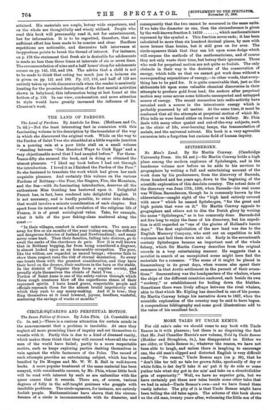CIRCLE-SQUARING AND PERPETUAL MOTION.
The Seven Follies of Science. By John Phin. (A. Constable and Co. 5s. net.)—There is a curious attraction for certain minds in the announcement that a problem is insoluble. At once they neglect all more promising lines of inquiry and set themselves to wrestle with it. Partly this is due to a kind of diseased vanity, which makes them think that they will succeed where all the wise men of the world have failed; partly to a more respectable motive, such as keeps exploring parties dashing themselves in vain against the white fastnesses of the Poles. The record of such attempts provides an entertaining subject, which has been handled by De Morgan and Mr. W. W. R. Ball in well-known books. A more popular treatment of the same material has been essayed, with considerable success, by Mr. Phin, whose little book will be read with interest by such as are unfamiliar with the queer crazes that it records. There are, of course, various degrees of folly in the self-taught geniuses who grapple with insoluble problems. The circle-squarers, for instance, are entirely foolish people. Mathematicians have shown that the circum- ference of a circle is incommensurable with its diameter, and consequently that the two cannot be measured in the same units. If we take the diameter as one, then the circumference is given by the well-known fraction 3.14169 , which mathematicians represent by the symbol Ir. This fraction never ends; it has been calculated to more than six hundred decimal places, by men with more leisure than brains, but it still goes on for ever. The circle-squarers think that they can hit upon some dodge which will surpass the methods of the mathematicians, and of course they not only waste their time, but betray their ignorance. Those who seek for perpetual motion are not quite so foolish. The only obstacle in their way is the doctrine of the conservation of energy, which tells us that we cannot get work done without a corresponding expenditure of energy,—in other words, that every- thing has to be paid for. It is quite conceivable that, just as the alchemists hit upon some valuable chemical discoveries in their attempts to produce gold from lead, the seekers after perpetual motion may come across some hitherto unsuspected and untapped source of energy. The recent researches into radio-activity have revealed such a source in the interatomic energy which is probably possessed by all matter. At the same time, it must be confessed that all the attempts at perpetual motion of which Mr. Phin tells us were based either on fraud or on fallacy. Mr. Phin deals with many other quaint and out-of-the-way subjects, such as the elixir of life, ever-burning lamps, the transmutation of metals, and the universal solvent. His book is a very agreeable excursion into a forgotten but curious field of human inquiry.


























































 Previous page
Previous page